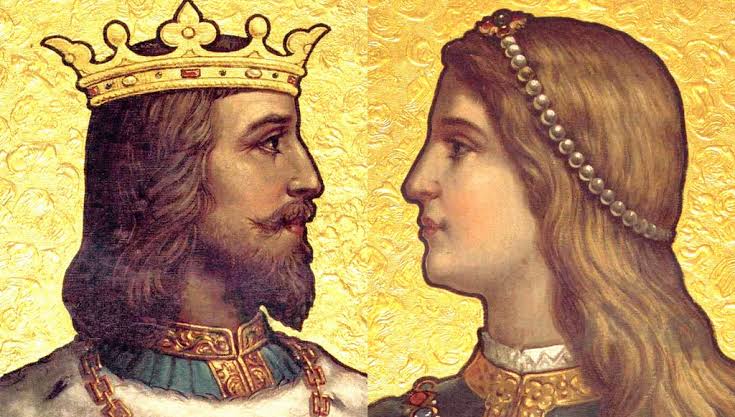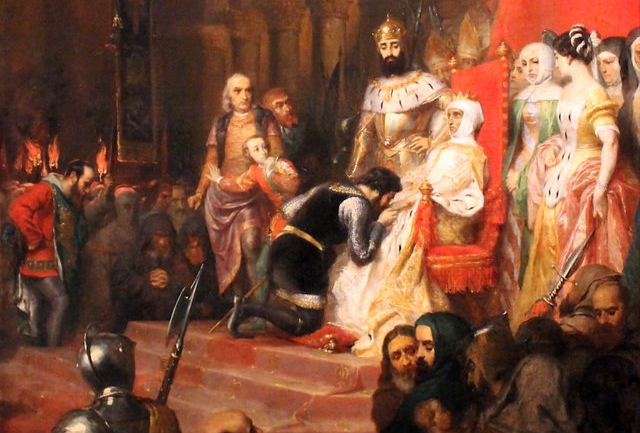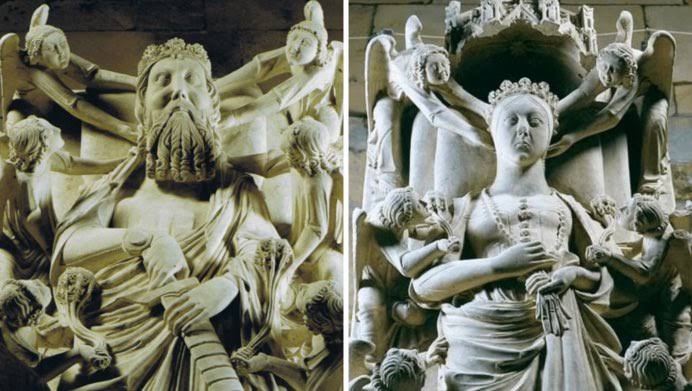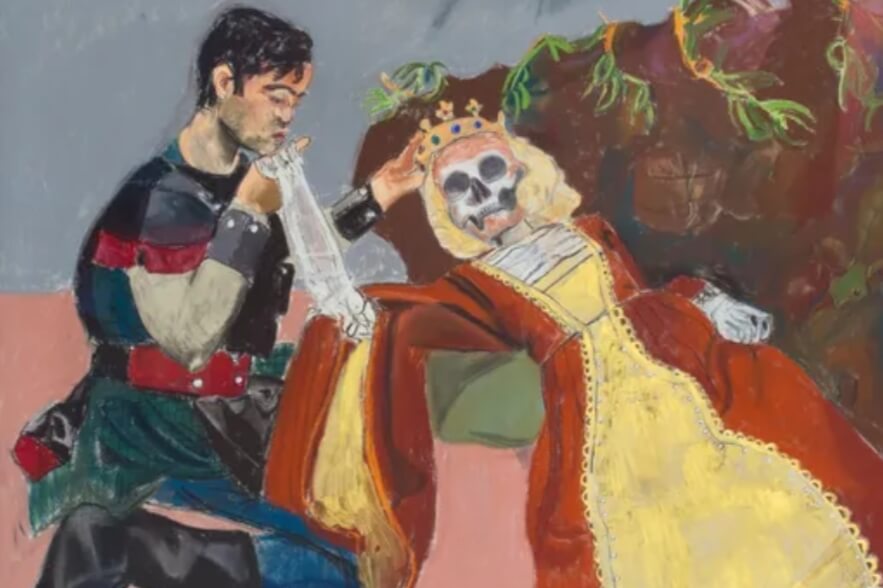In 1355, King Pedro of Portugal crowned Inês de Castro as the ‘dead’ queen, making her the only queen in the nation’s history to be crowned posthumously.
A macabre love story and their secret marriage between Inês de Castro and Dom Pedro of Portugal ranks as one of the most disastrous royal weddings in history.
It caused a Civil War, cost Inês De Castro her life, and by the time it was all said and done, the King of Portugal found himself sitting on a throne next to a dead queen.
So today, we’re going to look at the 14th-century prince Pedro, who crowned his corpse bride, Inês de Castro, the dead queen.
The Love Story Pedro and Inês
Inês Perez de Castro was born the daughter of Pedro Fernandez de Castro sometime between 1320 and 1325. Her lord father was an illegitimate grandson of Sancho IV, King of Castile, Spain.
King Alfonso of Portugal considered Inês illegitimate and therefore unfit for his son, Dom Pedro. To complicate matters, Ines was a lady in waiting for her cousin, Infanta Constanza of Castile.
In 1340, Constanza traveled to Portugal to marry Pedro. The marriage was supposed to bond Portugal and Castile, making peace between the warring states.
Unfortunately, for everyone who was banking on this marriage to bring an end to the conflict, Pedro ruined his father’s plans by falling in love with Inês instead.
Pedro became smitten with Inês in 1340, the same year he married her noble cousin and mistress. Pedro sent secret love letters to Ines because their relationship was forbidden.
King Alfonso wasn’t the only one who opposed the affair between Dom Pedro and Inês as Constanza, Pedro’s wife, also tried to break up the lovers. Infuriated by their affair, Constanza hatched a devious plot.
The Godmother

When she gave birth to their son, Dom Luis, Constanza asked Inês to be the boy’s godmother. According to the Catholic Church, godparents were considered blood relatives.
If Inês accepted, it would seriously hamstring her relationship with Pedro as she and Pedro would legally become family members and their affair could be labeled as a crime.
But Inês avoided the trap by refusing the role and continuing her relationship with Pedro. Of course, rejecting Constanza’s generous offer wasn’t consequence-free either.
Alfonso banished her to Castile in 1344 in retaliation. It was not great for the lovers, but it was certainly better than seeing their relationship criminalized.
In 1345, Constanza died after giving birth to the couple’s third child. Pedro barely mourned her loss. Instead, he seized on the opportunity to end his father’s banishment of Inês and moved her in with him.
According to Pedro, he and Inês married in secret against his father’s wishes. The arrangement technically made her the next queen of Portugal.
To further complicate matters, the couple had four children. King Alfonso worried about the influence of Inês and her Castilian brothers wielded over his heir. So he began plotting to get rid of her.
Assassination of Inês de Castro
In 1355, after Pedro had carried on a 15-year relationship with her against his father’s wishes, King Alfonso finally ordered Inês’s death.
Sounds pretty cold. But Alfonso had his reasons. As far as he was concerned, Inês was a threat to his kingdom. He was worried that she and her family held too much influence over his son.
He also feared a succession war if Pedro’s children with Inês tried to claim the throne. Basically, he was trying to avoid a Game of Thrones situation.
Alfonso had always disapproved of Inês because he considered her nobility illegitimate. But after ordering her death, Alfonso heard one last appeal from his presumed daughter-in-law.
She threw herself at his feet surrounded, by his grandchildren to plead for her life. Afonso allegedly left the room, telling his advisors to do whatever they wanted.

After King Alfonso decided he couldn’t risk the threat Inês’s Castilian bloodline posed to his kingdom, the King hired three men to end his daughter-in-law’s life in 1355.
Remember that Game of Thrones reference earlier? Well, Inês’s assassination played out like a real-life Red Wedding. The cutthroats waited until Dom Pedro was away from home.
Then they surprised Inês and carried out their gruesome orders. Most sources say the men stabbed Inês, while one grislier account claims they actually removed her head.
Whatever the method, sources agree on one detail. The assassins slew Inês in front of her children.
Pedro the Cruel
Dom Pedro returned to his home to find his lover and the mother of some of his children slain and knew instantly that his father, King Alfonso, was behind the act.
With the backing of Inês’s brothers, Pedro declared war on his father, rallying troops and marching toward his father’s city.
After months of conflict, Pedro’s mother convinced him to call a truce. Having a soft spot for his old mother, Pedro eventually relented.
In 1357, Alfonso passed, and Pedro was crowned King Peter I of Portugal.
If you thought that his father’s passing and the assumption of the throne would have calmed Pedro down, let’s assure you that they 100% did not.
He never forgave his father or the men who killed Inês. And as soon as he took the throne in 1357, Pedro’s focus turned to vengeance.
He brought two of the men who killed Inês to his castle where he reportedly exacted his payback in a particularly memorable way.
Pedro threw a dinner party at which both men had their hearts torn out while they were still alive. Pedro made a bone-chilling quip about his broken heart before removing their hearts from his own hands.
When news of Pedro’s justice became public, the King earned the extremely appropriate moniker of Pedro the Cruel.
The Dead Queen

As Inês had been deceased for several years when King Pedro announced the pair had secretly married years earlier.
The announcement bt Pedro meant that Inês was technically Portugal’s queen (dead), making her the only queen in the nation’s history to be crowned posthumously.
King Pedro wrapped his wife’s decaying body in royal robes for her final moment in the spotlight. According to an 1852 account, Pedro ordered Inês’ body placed on a throne beside him during the ceremony.
Pedro publicly swore to the fact of their marriage at Braganca. A dispensation from Rome caused her to be proclaimed queen and crowned as such and compelled all the nobles to do her corpse homage and kiss the cold dead hand.
History remembers those who flex the hardest, and there are few greater flexes than forcing a room full of sycophants to kiss your wife’s rotting hand.
Though some historians and academics insist the tale is just a legend concocted to boost Pedro’s cred as King Peter the Cruel.
Whatever the case, after her last public appearance as Pedro’s queen, Inês’s body was interred in a marble sarcophagus where she was allowed to rest without having to be escorted back out for any more ceremonies.
Inês de Castro Tomb

In 1360 or 1361, King Pedro ordered his men to transport Inês’s remains to the Royal Monastery of Alcobaca. She was laid to rest in a marble tomb depicting her earthly body held by angels.
On his own tomb Pedro, had a stone carver recreate his love story with his queen, including the harsh end to her life.
The story, told in concentric wheels, shows Inês and Pedro with their children as well as the arrival of the assassins and Inês’s slaying.
It also depicts Pedro’s revenge. For more than 650 years, Pedro and Inês have rested next to each other, which is appropriate, considering the inscription on their tombs read until the end of the world.
The love story of Inês Perez de Castro and Dom Pedro has been retold repeatedly throughout the centuries in several forms.
The tale was also recently recounted in the 2005 Portuguese television series Pedro y Inês and a 2018 film with a slightly more straightforward title, The Dead Queen.
